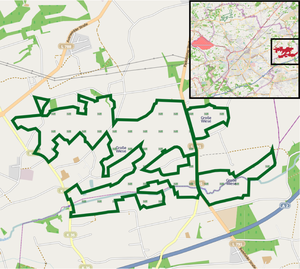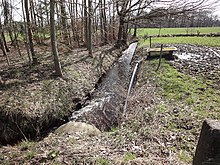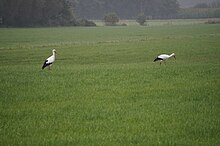Big meadow
|
Big meadow
|
|
|
View of the nature reserve |
|
| location | North Rhine-Westphalia , Germany |
| surface | 229 ha |
| Identifier | NSG GT-030 |
| WDPA ID | 318465 |
| Geographical location | 51 ° 55 ' N , 8 ° 29' E |
| Setup date | May 31, 1999 |
| administration | Lower landscape authority of the Gütersloh district |
The Große Wiese is a nature reserve of around 229 hectares , which is mainly located in the city of Gütersloh and a smaller part (approx. 31.38 hectares) in the city of Verl , both in the district of Gütersloh , administrative district of Detmold . On May 31, 1999 it was officially designated as such under the number GT-030 - as the last wetland protection area in the Gütersloh district to date.
The Große Wiese is a larger, contiguous grassland complex with varying levels of use. In contrast to the other wet meadow protection areas in the Gütersloh district, the proportion of arable land is relatively high at over 10%. A part of the areas is cultivated as so-called alternating grassland (arable soils that are alternately used as grassland or arable land) , in a special way that does not exist in the other wet meadow protection areas of the Gütersloh district .
In the south the Dalke flows through the area. Within the Große Wiese, the Dalke also flow to the right of the Hasselbach and the almost 5.5 km long Bekelbach , after it has crossed the area designated as NSG coming from the northeast. The Bekelbach supplies numerous ditches within the Großer Wiese with water.
flora
In the 1997 vegetation period , 355 vascular plant species were found, 26 of which are on the red list and a further 17 are on the warning list of the state of North Rhine-Westphalia . The sometimes large populations of endangered plant species are particularly remarkable. These include species such as the tubular horse seed (also called tubular water fennel ) and the water geiskraut . Most of the endangered plant species can be found at the ditches. On many grassland areas, the typical wetland flora is significantly depleted as a result of intensive cultivation.
fauna
When the territory was mapped in 1997, 43 breeding bird species were found in the nature reserve and in adjacent areas. With the lapwing and the curlew, two key species of the wet meadows regularly breed in the area.
See also
Web links
- Nature reserve "Große Wiese" (GT-030) in the specialist information system of the State Office for Nature, Environment and Consumer Protection in North Rhine-Westphalia
- World Database on Protected Areas - Big Meadow (English)




